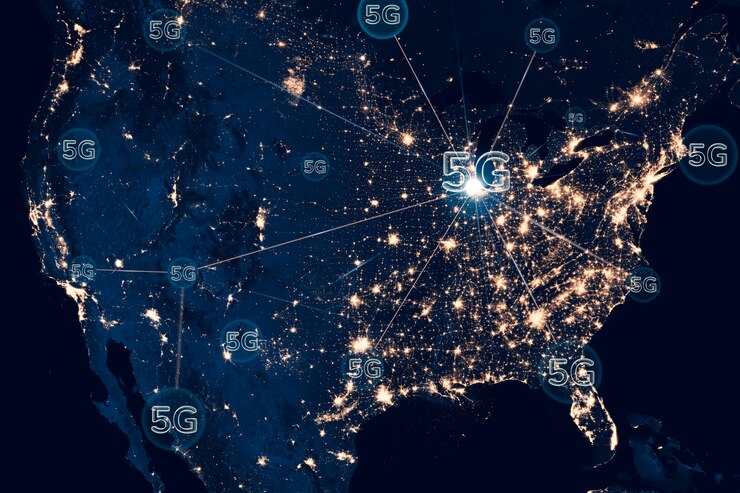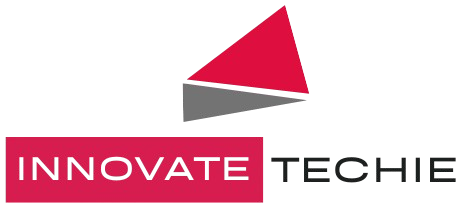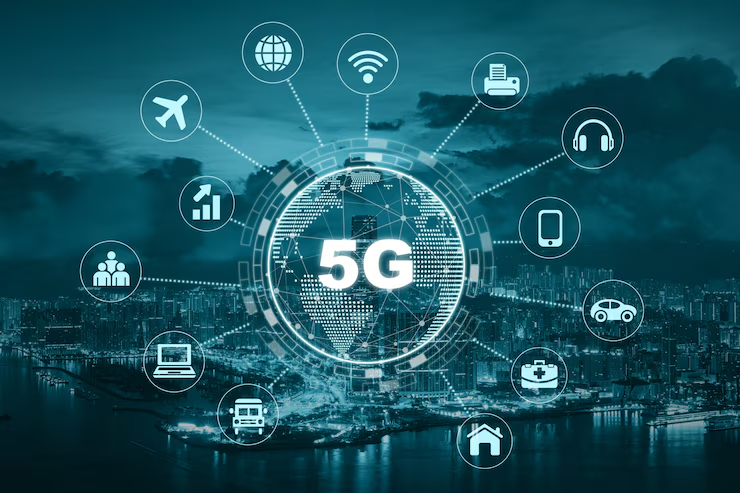We are on the verge of a new age in connectivity thanks to the digital revolution, where 5G and the Internet of Things (IoT) are revolutionizing the way we interact with our surroundings. These developments signify a fundamental change in the way we live, work, and play—they go beyond simply quicker internet and more intelligent gadgets.
A smarter future where everything from our homes to our cities can communicate effortlessly is made possible by the confluence of 5G and IoT, which will enhance productivity, innovation, and sustainability.
Understanding 5G and IoT: A New Era of Connectivity
Before delving into the synergy between 5G and IoT, it’s crucial to understand what these technologies are and how they function.
5G Technology: The Fifth Generation of Wireless Networks
The most recent version of a sequence of breakthroughs that started with 1G in the 1980s is called 5G, or the fifth generation of wireless technology. While higher speeds and better connectivity have been brought about by each generation, 5G stands out for its capacity to accommodate a large number of devices, offer extremely low latency, and offer dependable connections.

A GSMA estimate projects that by 2025, 5G networks would have more than 1.2 billion connections worldwide, serving one-third of the world’s population.
The key features of 5G include:
- Enhanced Mobile Broadband (eMBB): Offering faster download and upload speeds, enabling real-time video streaming, virtual reality, and other data-intensive applications.
- Massive Machine-Type Communications (mMTC): Supporting a vast number of connected devices, ideal for IoT ecosystems where billions of sensors and devices need to communicate.
- Ultra-Reliable Low Latency Communications (URLLC): Providing near-instantaneous response times, critical for applications like autonomous vehicles and remote surgery.
The Internet of Things (IoT): A Connected Ecosystem
The network of physical objects—devices, cars, appliances, and more—embedded with sensors, software, and other technologies that allow them to gather and share data is known as the “Internet of Things.” The ability of IoT devices to communicate with centralized systems and with one another creates a linked environment that promotes efficiency, automation, and more informed decision-making.
According to Statista, there will be over 29 billion linked IoT devices globally by 2024; by 2030, that figure is predicted to increase to 75 billion. The increasing need for sophisticated healthcare solutions, smart homes, and industrial automation is driving the proliferation of linked devices.
The Synergy of 5G and IoT: A Smarter Future
IoT and 5G together are nothing short of revolutionary. IoT offers the foundation for a connected world, but 5G offers the capacity, dependability, and speed required to realize this goal. Here’s how 5G is enabling IoT to reach its full potential in a variety of industries:

1. Smart Cities: Enhancing Urban Living
Leading the way in the 5G-IoT revolution are smart cities, which use networked devices to better manage resources, enhance public services, and improve citizens’ quality of life. Smart city solutions, which optimize urban infrastructure, rely on real-time data for everything from waste disposal to traffic control. As an illustration, Barcelona, a leader in smart city projects, has installed Internet of Things sensors all around the city to regulate street lighting, traffic flow, and air quality monitoring. These technologies can function more effectively with 5G’s low latency and high capacity, lowering energy costs and enhancing public safety.
2. Healthcare: Revolutionizing Patient Care
The convergence of 5G and IoT promises great benefits for the healthcare sector. Real-time patient monitoring is made possible by connected medical equipment, which lowers the need for hospital stays and promotes proactive care. Smartwatches and other wearables are able to monitor vital signs and notify medical professionals of any irregularities.
According to a research by the International Data Corporation (IDC), IoT will be used by 40% of healthcare organizations by 2025 to enhance patient outcomes, and 5G will be essential in making these developments possible. Personalized treatment plans, remote surgery, and telemedicine are just a few instances of how 5G and IoT are revolutionizing healthcare.
3. Manufacturing: Driving Industry 4.0
Industry 4.0, which is defined by the application of automation, data sharing, and smart manufacturing techniques, is a transition that the manufacturing sector is going through. IoT devices, which offer real-time data that can be utilized to enhance production processes, are crucial parts of this new industrial landscape. Examples of these devices are sensors and robots.
By enabling the enormous number of linked devices needed in a smart factory, 5G improves these capabilities. McKinsey & Company estimates that by 2030, the manufacturing sector’s adoption of 5G and IoT could boost the world economy by up to $2.2 trillion. This is because there is a chance for higher productivity, less downtime, and better-quality products.
4. Agriculture: Cultivating a Connected Farm
Another sector that stands to gain from the combination of 5G and IoT is agriculture. IoT devices are used in precision farming techniques to measure crop health, monitor soil conditions, and control irrigation systems. Farmers may now make data-driven decisions that boost crop yields while using fewer resources thanks to these technology. These systems will be able to function more efficiently with the arrival of 5G, offering real-time data and facilitating the smooth operation of automated machinery over wide areas.
By 2050, smart farming could help feed a growing global population by increasing agricultural production by as much as 70%, according to projections from the Food and Agriculture Organization (FAO).
5. Transportation: Enabling Autonomous Vehicles
As driverless cars become more prevalent on our roads, the transportation sector is about to undergo a significant transition. These cars can navigate and make judgments in real time thanks to an intricate web of sensors, cameras, and communication systems.
Autonomous vehicles depend on 5G’s ultra-reliable low latency connections to operate safely since it enables them to respond to their surroundings almost instantly. Advances in 5G and IoT technology are predicted to propel the global market for autonomous vehicles to $560 billion by 2026, according to a PwC analysis.
Challenges and Considerations in the 5G-IoT Ecosystem
Undoubtedly exciting, the future of 5G and IoT is not without difficulties. For businesses and governments to properly utilize the potential of new technologies, a number of important concerns must be addressed.

1. Security Concerns: Protecting a Connected World
The likelihood of cyberattacks rises with the number of connected gadgets. Because IoT devices are frequently susceptible to security lapses, hackers target them frequently. These dangers are enhanced with the rollout of 5G, which offers higher bandwidth and device capacities.
A Kaspersky analysis claims that in the first half of 2023, the number of cyberattacks against IoT devices doubled, underscoring the importance of strong security measures. To safeguard their IoT ecosystems, businesses need to put in place robust security processes that include frequent software updates, authentication, and encryption.
2. Infrastructure Development: Building the 5G Network
Significant infrastructure investment is needed for the deployment of 5G networks, including the construction of new fiber-optic cables, base stations, and antennas. This can be especially difficult in isolated and rural locations where the expense of developing infrastructure can be unaffordable.
By 2025, the Global System for Mobile Communications (GSMA) projects that the deployment of 5G will cost $1.1 trillion worldwide. Governments and businesses in the private sector need to collaborate to guarantee that 5G networks are available to everyone, everywhere.
3. Interoperability: Ensuring Seamless Integration
Making sure billions of IoT devices from various manufacturers function together on the same network presents a significant problem. For the Internet of Things to function as a whole, devices from different manufacturers must be able to communicate with one another.
Common protocols for Internet of Things devices are being developed by standards bodies like the Institute of Electrical and Electronics Engineers (IEEE) and the International Organization for Standardization (ISO). However, continued cooperation amongst industry players will be necessary to achieve complete compatibility.

Conclusion: Embracing a Smarter Future
The world as we know it is about to change due to the confluence of 5G and IoT, opening up new possibilities for sustainability, efficiency, and creativity. The potential applications are numerous and diverse, ranging from autonomous cars to smart cities, and they all point to a more intelligent and connected future. But there are drawbacks to this change as well, such as interoperability problems, infrastructure development, and security risks. For businesses to fully reap the rewards of 5G and IoT, they must take the initiative to address these issues.
Stay ahead with the latest tech trends, tutorials, and innovation at InnovatTechie.co – connect with us for exclusive updates! Get In Touch


1 Comment
I am extremely inspired with your writing talents and also with
the layout to your weblog. Is this a paid
topic or did you customize it yourself? Anyway keep up the excellent high quality writing, it is rare to look a nice blog like this one today.